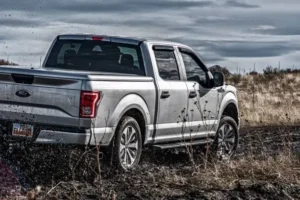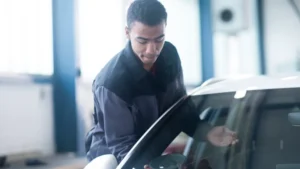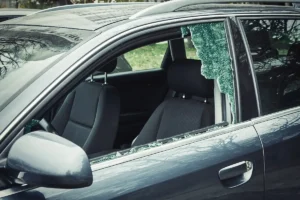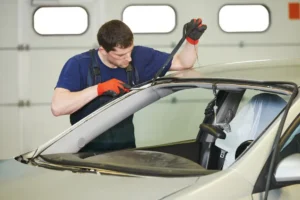Ford F150 Rear Window Replacement Ford F150 rear window replacement is essential for maintaining the...
Decoding the Mystery| Unraveling the Causes of Burning Smell from Car Vents
Burning smell from car vents is an issue that can cause immediate concern for drivers and passengers alike. When an unusual scent permeates the vehicle’s interior, it not only raises questions about the overall health of the car but also prompts a need for swift investigation and resolution. This distinct odor can indicate various underlying problems within the vehicle’s systems, ranging from issues with the heating components to potential electrical malfunctions.
Common Causes of Burning Smell from Car Vents
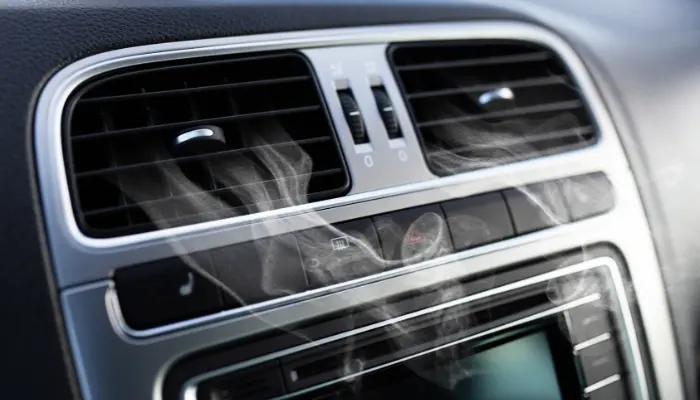
A burning smell coming from car vents can be indicative of various issues. Here are some common causes:
Overheating components in the engine: If certain engine components are overheating, it can produce a burning odor that may enter the car through the vents.
Electrical issues or wiring problems: Faulty wiring or electrical problems within the car’s systems can generate heat and cause a burning smell.
Worn-out or damaged blower motor: The blower motor is responsible for circulating air through the vents. If it’s worn out or damaged, it may generate a burning smell as it struggles to function properly.
Issues with the heating system: Problems with the heating system, such as a malfunctioning heater core, can lead to the emission of burning odors.
Introduction of foreign substances into the vents: Foreign materials, like leaves or debris, may find their way into the car’s ventilation system, causing a burning smell when they come into contact with hot components.
Burning Smell from Car Vents When Heat is On
If you notice a burning smell coming from your car vents when the heat is on, it could indicate a problem with the heating system. Here are some tips for diagnosing and addressing heat-related burning odors:
Check for Debris: Inspect the area around the vents for any debris or foreign objects that may have found their way into the system. Leaves, plastic bags, or other items can sometimes get trapped and cause a burning smell when they come into contact with the heating elements.
Cabin Air Filter: A clogged or dirty cabin air filter can restrict airflow and cause the heating system to overheat. Check the cabin air filter and replace it if necessary. A dirty filter can also produce unpleasant odors when heated.
Inspect the Engine Compartment: Open the hood and visually inspect the engine compartment. Look for any signs of leaking fluids, especially around the heater core area. Leaking coolant can produce a sweet, syrupy smell when it comes into contact with hot engine components.
Heater Core Issues: The heater core is a key component of the heating system. A leaking or malfunctioning heater core can cause a burning smell. Look for signs of coolant leaks inside the car, such as a damp carpet on the passenger side.
Check for Electrical Issues: Overheating electrical components in the heating system can also produce a burning smell. Inspect the wiring and connections for any signs of melting or burning. If you notice any electrical issues, it’s crucial to address them promptly to prevent potential fire hazards.
Monitor Temperature Levels: Keep an eye on the temperature gauge while the car is running. If the engine is overheating, it can lead to burning smells. Check the coolant levels and ensure that the cooling system is functioning properly.
Avoid DIY Repairs for Complex Issues: If you are unable to identify the cause of the burning smell or if the issue seems complex, it’s advisable to seek professional help. Complex heating system problems, such as a malfunctioning heater core or issues with electrical components, may require specialized knowledge and tools for proper diagnosis and repair.
Burning Smell from Car Vents While Driving
Potential Causes Exacerbated While Driving
When the distinct smell of burning emanates from a car’s vents while in motion, several potential causes may be exacerbated by the vehicle’s movement.
Increased Airflow and Contributing Factors
Factors such as increased airflow can play a crucial role in intensifying the burning smell. Understanding how these elements contribute is essential in diagnosing and addressing the issue.
Safety Concerns While Driving with Burning Odors
Driving while experiencing a burning odor poses potential safety risks. Addressing these concerns is paramount to ensure the well-being of the driver, passengers, and the overall road safety.
Immediate Steps to Take During Driving
In the event of a burning smell while driving, it’s crucial to take immediate steps to mitigate risks and address the underlying problem. This section outlines actions that should be promptly taken to ensure a safe driving environment.
Burning Rubber Smell from Car Vents
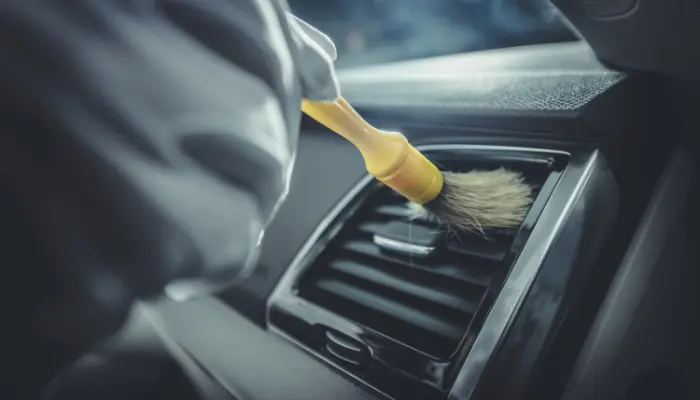
Exploring specific characteristics of a burning rubber smell:
When encountering a burning rubber smell in your car, it’s crucial to pay attention to specific characteristics of the odor. Note the intensity, duration, and any accompanying scents. Additionally, observe whether the smell is more prominent inside or outside the vehicle, and whether it occurs consistently or sporadically. These details can provide valuable clues about the potential source of the issue.
Potential sources of the burning rubber odor within the vehicle:
Overheating Components:
Check for overheating components such as the engine, brakes, or transmission. Overheating can cause rubber parts to emit a burning smell.
Drive Belts:
Inspect drive belts for wear and tear. Damaged or loose belts can generate friction, leading to a burning rubber odor.
Electrical Issues:
Electrical malfunctions can cause wires or insulation to overheat, resulting in a distinct burning smell. Investigate the electrical system for any visible damage or anomalies.
Clutch or Brakes:
Worn-out clutches or brakes can produce a burning rubber smell. Examine these components for signs of excessive heat or friction.
Fluid Leaks:
Check for any fluid leaks, such as oil or coolant, as they can come into contact with hot engine parts, generating a burning odor.
Steps to identify and address issues related to burning rubber smell:
Inspect Engine Compartment:
Open the hood and visually inspect the engine compartment for any signs of overheating, damaged belts, or fluid leaks.
Check Brake System:
Examine the brake system, including pads, rotors, and calipers, for wear and tear. Address any issues found during the inspection.
Examine Drive Belts:
Inspect drive belts for fraying, cracking, or looseness. Replace any damaged belts and ensure proper tension.
Investigate Electrical System:
Carefully examine the electrical system for damaged wires, connectors, or insulation. Address any electrical issues promptly.
Verify Fluid Levels:
Check fluid levels, including oil and coolant. Top up or replace fluids as needed and fix any leaks.
Professional Inspection:
If the issue persists or you’re unable to identify the source, seek professional help. A qualified mechanic can perform a thorough inspection and diagnose the problem accurately.
The importance of distinguishing between different burning smells for accurate diagnosis:
Different burning smells can indicate distinct issues within a vehicle. Distinguishing between them is crucial for accurate diagnosis and timely resolution of problems. For instance, a burning rubber smell might be caused by overheating components, while a burning oil smell could signify an oil leak. Identifying the specific odor helps in targeting the underlying issue, preventing potential damage, and ensuring the safety and reliability of the vehicle. If uncertain, consulting a professional mechanic is advisable to address the problem effectively.
DIY Tips for Investigating and Resolving Burning Smell Issues
Safe steps for drivers to investigate the source of the smell:
Pull Over Safely: If you detect a burning smell while driving, find a safe place to pull over and turn off the engine.
Pop the Hood: Allow the engine to cool for a few minutes before opening the hood.
Visual Inspection: Look for any visible signs of smoke from vent, burning, or damage in the engine compartment.
Check Vents: Inspect the air vents for debris, leaves, or any other obstruction.
Simple checks for common causes like debris in vents or visible damage:
Inspect Cabin Air Filter: A clogged or dirty cabin air filter can cause unpleasant odors. Check and replace if necessary.
Look for Leaks: Check for any fluid leaks under the vehicle. Fluids like oil, coolant, or brake fluid can produce a burning smell when they come into contact with hot engine components.
Examine Belts and Hoses: Inspect belts and hoses for signs of wear, damage, or slipping. A malfunctioning belt or hose can generate heat and produce a burning odor.
Check Electrical Components: Inspect wiring for visible damage. Electrical issues can result in a burning smell.
Precautions and warnings for DIY inspection to ensure safety:
Safety Gear: Wear protective gloves and eye gear to prevent injuries.
Avoid Touching Hot Components: Wait for the engine to cool down before touching any parts to prevent burns.
Use a Flashlight: For better visibility during inspections, especially in darker areas.
When to Seek Professional Help
Signs indicating the need for professional inspection and repair:
Persistent Smell: If the burning smell persists after DIY checks.
Unidentified Issues: When you are unable to identify the source of the smell.
Warning Lights: If dashboard warning lights are illuminated.
Odd Noises: Unusual sounds accompanying the smell may indicate serious issues.
Importance of addressing burning smells promptly to prevent potential damage:
Avoid Further Damage: Prompt attention to burning smells can prevent potential damage to critical vehicle components.
Ensure Safety: Ignoring burning smells may lead to unsafe driving conditions or even vehicle fires.
Benefits of consulting a qualified automotive technician for thorough diagnostics:
Expertise: Professional technicians have the knowledge and experience to accurately diagnose and repair complex issues. If you want professional guidance then Reliable Auto Glass is best in business.
Preventive Measures: Technicians can identify potential problems before they escalate, saving you from costly repairs in the long run.
Conclusion
Identifying and addressing burning smells emanating from car vents is crucial for maintaining vehicle safety and performance. The common causes of such odors often stem from issues related to the heating and ventilation system. Accumulated dust and debris, mold growth, or malfunctioning components can lead to unpleasant and potentially hazardous smells. Regular maintenance, including cleaning and replacing air filters, checking for any blockages, and ensuring proper functioning of the heating elements, can help prevent these problems. Feel free to contact us for any type of services or the queries like burning smell from car vents.
FAQs
Q: Why Do I Smell A Burning Odor Coming From My Car Vents?
A: The burning smell from car vents can result from various causes, including accumulated dust, mold growth, or issues with the heating system. Identifying the specific source is crucial for effective resolution.
Q: Is A Burning Smell From Car Vents Dangerous?
A: While not all instances are dangerous, some causes of burning smells can indicate potential issues with electrical or mechanical components. It is advisable to address the problem promptly to prevent further damage and ensure safety.
Q: What Should I Do If I Notice A Burning Smell In My Car?
A: If you detect a burning smell, it’s recommended to pull over safely, turn off the vehicle, and investigate the source. Avoid continuing to drive until you’ve identified and addressed the issue or consulted with a professional.
Q: Can A Clogged Air Filter Cause A Burning Smell In The Car Vents?
A: Yes, a clogged air filter can impede proper airflow, leading to overheating and potential burning smells. Regularly replacing or cleaning the air filter is essential for the health of your car’s HVAC system.
Q: How Can I Prevent Burning Smells From Car Vents?
A: Regular maintenance is key. Ensure your car’s heating and ventilation system is inspected, clean or replace air filters, and address any issues promptly. This proactive approach helps prevent unpleasant odors and maintains system efficiency.
Our Services
Our Latest Blogs
Affordable Kia Soul Window Replacement Services
Affordable Kia Soul Window Replacement Services Kia Soul window replacement is a necessary procedure that...
Professional Kia Window Replacement | Trusted Experts
Professional Kia Window Replacement | Trusted Experts Kia window replacement is crucial for maintaining the...
Hyundai Windshield Replacement Made Easy | Trusted Services
Hyundai Windshield Replacement Hyundai windshield replacement services are crucial for maintaining the integrity and safety...
Get A Quote
Should I tint my sunroof? This is a question that often arises when considering modifications to enhance a vehicle’s features. Sunroof tinting, a practice gaining popularity among car enthusiasts, involves applying a thin film to the sunroof glass. Before delving into the intricacies of this decision, it’s crucial to understand the basics of sunroof tinting and recognize the importance of contemplating whether to embark on this modification journey.
Benefits of Tinting a Sunroof
Heat Reduction and Temperature Control:
Tinted sunroofs can help in reducing the amount of heat that enters the vehicle, providing a cooler interior. This can be particularly beneficial during hot weather, as it helps in maintaining a comfortable temperature inside the car and reduces the need for excessive air conditioning.
Glare Reduction for Improved Visibility:
Tinted sunroofs can minimize glare from the sun, headlights, and other bright sources of light. This reduction in glare improves visibility for the driver and passengers, making it safer to drive, especially during periods of intense sunlight.
Protection Against UV Rays:
Sunroof tinting can act as a barrier against harmful ultraviolet (UV) rays. UV rays can cause damage to the skin and can lead to the fading of interior surfaces in the car. Tinted sunroofs help in blocking a significant portion of these UV rays, providing protection for both the occupants and the interior of the vehicle.
Enhanced Privacy and Security:
Tinted sunroofs contribute to increased privacy for the vehicle’s occupants. Passersby are less likely to see into the car, enhancing the overall sense of privacy. Additionally, the tinted film may add an extra layer of security by making it more difficult for potential thieves to see valuable items inside the vehicle.
How Dark Should I Tint My Sunroof?
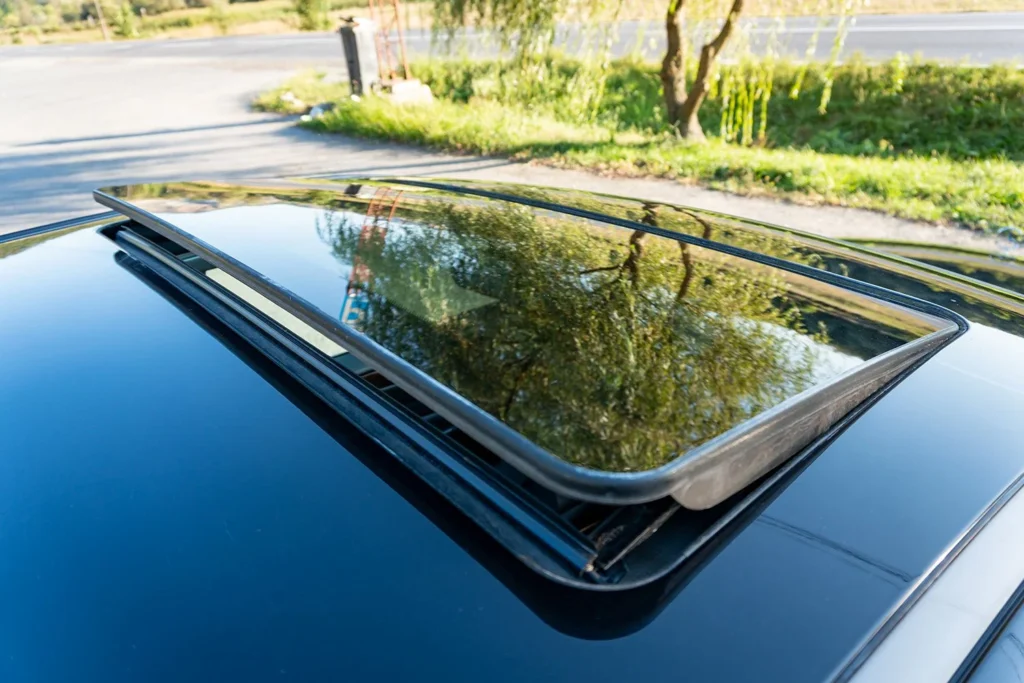
Explanation of Tint Darkness Levels:
Window tint darkness is measured by the percentage of light that can pass through the film. The lower the percentage, the darker the tint. Common tint darkness levels include:
50% and above: Light tint. Allows more light to pass through, offering minimal privacy and heat reduction.
35% to 50%: Light to moderate tint. Provides a balance between visibility and heat reduction.
20% to 35%: Moderate to dark tint. Offers increased privacy and heat reduction, but may affect nighttime visibility.
5% to 20%: Dark tint. Maximum privacy and heat reduction but may significantly limit visibility, especially at night.
Below 5%: Limo tint. Almost complete privacy, but legal restrictions often apply.
DIY vs. Professional Tinting Services:
DIY Tinting:
Pros: Cost-effective, flexibility in choosing tint shades, can be done at home.
Cons: Requires skill and patience, potential for bubbles and imperfections, may not have a professional finish.
Professional Tinting Services:
Pros: Expertise in installation, professional finish, often comes with a warranty, time-saving.
Cons: Higher cost compared to DIY, need to find a reputable installer.
Considerations for Sunroof Design and Structure:
Complexity: Some sunroofs have intricate designs or mechanisms that may complicate the tinting process. It’s essential to consider the sunroof’s structure and whether it may impact the tinting procedure.
Legal Regulations: Check local regulations regarding the allowable tint levels for sunroofs. Exceeding legal limits could result in fines.
Compatibility: Ensure that the tinting material is compatible with the type of glass used in your sunroof to avoid potential damage or interference with its functionality.
Potential Warranty Implications:
DIY Tinting and Warranty: If you opt for a DIY tinting approach, be aware that it might void the warranty on your sunroof. Manufacturers often recommend professional installation to maintain warranty coverage.
Professional Tinting and Warranty: Reputable professional tinting services may offer warranties on their work. It’s important to inquire about these warranties and understand the terms and conditions. If you want professional guidance or services then Texas Reliable Services is best in the business.
Steps to Tinting a Sunroof
Professional Installation Process:
Choose the Right Tint Film: Consult with a professional tinting service to select the appropriate tint film for your sunroof. Consider factors such as legal restrictions, UV protection, and personal preferences.
Clean the Sunroof: Thoroughly clean the sunroof glass to ensure there are no dust, dirt, or debris particles that may interfere with the tinting process.
Precise Measurements: Measure the sunroof dimensions accurately to cut the tint film precisely. Professionals often use computerized cutting equipment for precision.
Film Application: Carefully apply the tint film to the sunroof glass, making sure to smooth out any air bubbles or wrinkles. Professionals often use tools like squeegees for this purpose.
Heat Shrinking: If needed, heat shrinking may be applied to ensure the tint film fits the sunroof’s contours perfectly. This step requires skill and experience.
Trimming Excess Film: Trim any excess tint film to ensure a neat and professional finish. Precision is key to achieving a seamless look.
Drying Time: Allow sufficient time for the tint film to dry and adhere properly to the sunroof glass. Professional installations may involve specific curing processes.
Quality Check: Inspect the tinted sunroof for any imperfections, such as bubbles, creases, or debris trapped under the film. Address any issues before completing the installation.
DIY Tinting Tips and Precautions:
Choose a Suitable Environment: Perform the tinting in a clean, dust-free, and well-ventilated area to minimize the risk of debris getting trapped under the film.
Follow Instructions: Read and follow the manufacturer’s instructions that come with the tint film carefully. Different films may have specific application techniques.
Precise Cutting: Take your time to measure and cut the tint film accurately. Use a sharp utility knife and a straight edge for clean lines.
Application in Sections: Apply the tint film in smaller sections to manage the process better, smoothing out the film as you go to avoid bubbles.
Avoid Overstretching: Be cautious not to overstretch the film, as this can lead to distortions and affect the overall appearance.
Patiently Remove Air Bubbles: If air bubbles appear during the application, use a squeegee to gently push them towards the edges. Small bubbles may disappear as the tint dries.
Take Breaks: Tinting can be time-consuming, so take breaks to avoid fatigue, ensuring that you maintain focus and precision.
Maintenance of Tinted Sunroofs:
Wait Before Cleaning: Allow the tinted sunroof to cure fully before cleaning. This may take a few days, depending on the type of tint film used.
Use Mild Cleaning Solutions: Clean the tinted surface with a mild, non-ammonia-based cleaning solution and a soft, lint-free cloth to avoid scratching the film.
Avoid Abrasive Materials: Refrain from using abrasive materials, harsh chemicals, or sharp objects that may damage or scratch the tinted surface.
Regular Inspection: Periodically inspect the tinted sunroof for any signs of peeling, bubbling, or damage. Promptly address any issues to prevent further deterioration.
Professional Maintenance: Consider professional maintenance or sunroof repairs if you notice significant damage or if the tint begins to degrade over time.
Conclusion
Sunroof tinting is a decision that involves careful consideration of various factors. Summarizing the key points discussed, it is crucial to recognize that sunroof tinting offers benefits such as enhanced UV protection, reduced glare, and improved interior comfort. However, it is equally important to weigh the potential drawbacks, including legal restrictions and the impact on visibility, especially at night. Feel free to contact us for any type of services or the queries like should i tint my sunroof.
FAQs
Why Should I Consider Tinting My Sunroof?
Tinting your sunroof offers various benefits, including enhanced UV protection, reduced glare, and improved interior comfort. It can also contribute to a more aesthetically pleasing appearance.
Are There Any Legal Restrictions On Sunroof Tinting?
Yes, regulations regarding sunroof tinting vary by location. It’s crucial to check local laws to ensure compliance with permissible tint levels and avoid potential legal issues.
Will Tinting My Sunroof Affect Visibility, Especially At Night?
Tinting may have an impact on visibility, particularly at night. Choosing an appropriate tint level and consulting with professionals can help strike a balance between aesthetic preferences and practical considerations.
How Long Does Sunroof Tinting Typically Last?
The longevity of sunroof tinting depends on factors such as the quality of the tint film and installation. High-quality materials and professional installation can contribute to a longer lifespan.
Can I Tint My Sunroof Myself, Or Should I Seek Professional Help?
While some individuals may opt for DIY tinting, professional installation is recommended for optimal results. Professionals have the expertise to ensure a proper fit and adhere to legal standards.
Does Sunroof Tinting Require Special Maintenance?
Tinted sunroofs generally require minimal maintenance. Regular cleaning with mild, non-abrasive cleaners is advisable to preserve the tint film’s clarity and longevity.
Our Services
Our Latest Blogs
Ford F150 Rear Window Replacement
Ford F150 Rear Window Replacement Ford F150 rear window replacement is essential for maintaining the...
Affordable Kia Soul Window Replacement Services
Affordable Kia Soul Window Replacement Services Kia Soul window replacement is a necessary procedure that...
Professional Kia Window Replacement | Trusted Experts
Professional Kia Window Replacement | Trusted Experts Kia window replacement is crucial for maintaining the...
Hyundai Windshield Replacement Made Easy | Trusted Services
Hyundai Windshield Replacement Hyundai windshield replacement services are crucial for maintaining the integrity and safety...
Get A Quote
Should I tint my sunroof? This is a question that often arises when considering modifications to enhance a vehicle’s features. Sunroof tinting, a practice gaining popularity among car enthusiasts, involves applying a thin film to the sunroof glass. Before delving into the intricacies of this decision, it’s crucial to understand the basics of sunroof tinting and recognize the importance of contemplating whether to embark on this modification journey.
Benefits of Tinting a Sunroof
Heat Reduction and Temperature Control:
Tinted sunroofs can help in reducing the amount of heat that enters the vehicle, providing a cooler interior. This can be particularly beneficial during hot weather, as it helps in maintaining a comfortable temperature inside the car and reduces the need for excessive air conditioning.
Glare Reduction for Improved Visibility:
Tinted sunroofs can minimize glare from the sun, headlights, and other bright sources of light. This reduction in glare improves visibility for the driver and passengers, making it safer to drive, especially during periods of intense sunlight.
Protection Against UV Rays:
Sunroof tinting can act as a barrier against harmful ultraviolet (UV) rays. UV rays can cause damage to the skin and can lead to the fading of interior surfaces in the car. Tinted sunroofs help in blocking a significant portion of these UV rays, providing protection for both the occupants and the interior of the vehicle.
Enhanced Privacy and Security:
Tinted sunroofs contribute to increased privacy for the vehicle’s occupants. Passersby are less likely to see into the car, enhancing the overall sense of privacy. Additionally, the tinted film may add an extra layer of security by making it more difficult for potential thieves to see valuable items inside the vehicle.
How Dark Should I Tint My Sunroof?

Explanation of Tint Darkness Levels:
Window tint darkness is measured by the percentage of light that can pass through the film. The lower the percentage, the darker the tint. Common tint darkness levels include:
50% and above: Light tint. Allows more light to pass through, offering minimal privacy and heat reduction.
35% to 50%: Light to moderate tint. Provides a balance between visibility and heat reduction.
20% to 35%: Moderate to dark tint. Offers increased privacy and heat reduction, but may affect nighttime visibility.
5% to 20%: Dark tint. Maximum privacy and heat reduction but may significantly limit visibility, especially at night.
Below 5%: Limo tint. Almost complete privacy, but legal restrictions often apply.
DIY vs. Professional Tinting Services:
DIY Tinting:
Pros: Cost-effective, flexibility in choosing tint shades, can be done at home.
Cons: Requires skill and patience, potential for bubbles and imperfections, may not have a professional finish.
Professional Tinting Services:
Pros: Expertise in installation, professional finish, often comes with a warranty, time-saving.
Cons: Higher cost compared to DIY, need to find a reputable installer.
Considerations for Sunroof Design and Structure:
Complexity: Some sunroofs have intricate designs or mechanisms that may complicate the tinting process. It’s essential to consider the sunroof’s structure and whether it may impact the tinting procedure.
Legal Regulations: Check local regulations regarding the allowable tint levels for sunroofs. Exceeding legal limits could result in fines.
Compatibility: Ensure that the tinting material is compatible with the type of glass used in your sunroof to avoid potential damage or interference with its functionality.
Potential Warranty Implications:
DIY Tinting and Warranty: If you opt for a DIY tinting approach, be aware that it might void the warranty on your sunroof. Manufacturers often recommend professional installation to maintain warranty coverage.
Professional Tinting and Warranty: Reputable professional tinting services may offer warranties on their work. It’s important to inquire about these warranties and understand the terms and conditions. If you want professional guidance or services then Texas Reliable Services is best in the business.
Steps to Tinting a Sunroof
Professional Installation Process:
Choose the Right Tint Film: Consult with a professional tinting service to select the appropriate tint film for your sunroof. Consider factors such as legal restrictions, UV protection, and personal preferences.
Clean the Sunroof: Thoroughly clean the sunroof glass to ensure there are no dust, dirt, or debris particles that may interfere with the tinting process.
Precise Measurements: Measure the sunroof dimensions accurately to cut the tint film precisely. Professionals often use computerized cutting equipment for precision.
Film Application: Carefully apply the tint film to the sunroof glass, making sure to smooth out any air bubbles or wrinkles. Professionals often use tools like squeegees for this purpose.
Heat Shrinking: If needed, heat shrinking may be applied to ensure the tint film fits the sunroof’s contours perfectly. This step requires skill and experience.
Trimming Excess Film: Trim any excess tint film to ensure a neat and professional finish. Precision is key to achieving a seamless look.
Drying Time: Allow sufficient time for the tint film to dry and adhere properly to the sunroof glass. Professional installations may involve specific curing processes.
Quality Check: Inspect the tinted sunroof for any imperfections, such as bubbles, creases, or debris trapped under the film. Address any issues before completing the installation.
DIY Tinting Tips and Precautions:
Choose a Suitable Environment: Perform the tinting in a clean, dust-free, and well-ventilated area to minimize the risk of debris getting trapped under the film.
Follow Instructions: Read and follow the manufacturer’s instructions that come with the tint film carefully. Different films may have specific application techniques.
Precise Cutting: Take your time to measure and cut the tint film accurately. Use a sharp utility knife and a straight edge for clean lines.
Application in Sections: Apply the tint film in smaller sections to manage the process better, smoothing out the film as you go to avoid bubbles.
Avoid Overstretching: Be cautious not to overstretch the film, as this can lead to distortions and affect the overall appearance.
Patiently Remove Air Bubbles: If air bubbles appear during the application, use a squeegee to gently push them towards the edges. Small bubbles may disappear as the tint dries.
Take Breaks: Tinting can be time-consuming, so take breaks to avoid fatigue, ensuring that you maintain focus and precision.
Maintenance of Tinted Sunroofs:
Wait Before Cleaning: Allow the tinted sunroof to cure fully before cleaning. This may take a few days, depending on the type of tint film used.
Use Mild Cleaning Solutions: Clean the tinted surface with a mild, non-ammonia-based cleaning solution and a soft, lint-free cloth to avoid scratching the film.
Avoid Abrasive Materials: Refrain from using abrasive materials, harsh chemicals, or sharp objects that may damage or scratch the tinted surface.
Regular Inspection: Periodically inspect the tinted sunroof for any signs of peeling, bubbling, or damage. Promptly address any issues to prevent further deterioration.
Professional Maintenance: Consider professional maintenance or sunroof repairs if you notice significant damage or if the tint begins to degrade over time.
Conclusion
Sunroof tinting is a decision that involves careful consideration of various factors. Summarizing the key points discussed, it is crucial to recognize that sunroof tinting offers benefits such as enhanced UV protection, reduced glare, and improved interior comfort. However, it is equally important to weigh the potential drawbacks, including legal restrictions and the impact on visibility, especially at night. Feel free to contact us for any type of services or the queries like should i tint my sunroof.
FAQs
Why Should I Consider Tinting My Sunroof?
Tinting your sunroof offers various benefits, including enhanced UV protection, reduced glare, and improved interior comfort. It can also contribute to a more aesthetically pleasing appearance.
Are There Any Legal Restrictions On Sunroof Tinting?
Yes, regulations regarding sunroof tinting vary by location. It’s crucial to check local laws to ensure compliance with permissible tint levels and avoid potential legal issues.
Will Tinting My Sunroof Affect Visibility, Especially At Night?
Tinting may have an impact on visibility, particularly at night. Choosing an appropriate tint level and consulting with professionals can help strike a balance between aesthetic preferences and practical considerations.
How Long Does Sunroof Tinting Typically Last?
The longevity of sunroof tinting depends on factors such as the quality of the tint film and installation. High-quality materials and professional installation can contribute to a longer lifespan.
Can I Tint My Sunroof Myself, Or Should I Seek Professional Help?
While some individuals may opt for DIY tinting, professional installation is recommended for optimal results. Professionals have the expertise to ensure a proper fit and adhere to legal standards.
Does Sunroof Tinting Require Special Maintenance?
Tinted sunroofs generally require minimal maintenance. Regular cleaning with mild, non-abrasive cleaners is advisable to preserve the tint film’s clarity and longevity.
Our Services
Our Latest Blogs
Ford F150 Rear Window Replacement
Ford F150 Rear Window Replacement Ford F150 rear window replacement is essential for maintaining the...
Affordable Kia Soul Window Replacement Services
Affordable Kia Soul Window Replacement Services Kia Soul window replacement is a necessary procedure that...
Professional Kia Window Replacement | Trusted Experts
Professional Kia Window Replacement | Trusted Experts Kia window replacement is crucial for maintaining the...
Hyundai Windshield Replacement Made Easy | Trusted Services
Hyundai Windshield Replacement Hyundai windshield replacement services are crucial for maintaining the integrity and safety...


